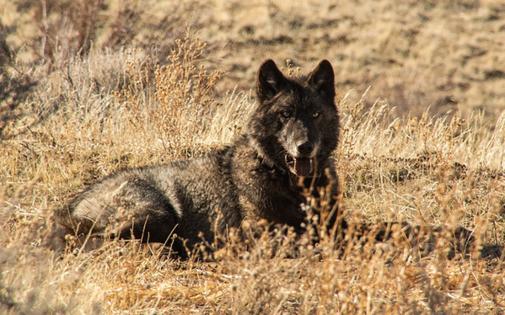Three new wolf packs discovered in Northern California
Published in News & Features
Continuing a growing trend, three new wolf packs have been confirmed in Northern California, increasing the population of the charismatic and controversial predator to 78 now — up from 44 animals in 2023 and only 7 in 2020.
The California Department of Fish and Wildlife has named the new packs the Ishi pack in eastern Tehama County, the Tunnison pack in central Lassen County, and the Ashpan pack in eastern Shasta County.
The new discovery, confirmed Tuesday, brings the number of known wolf packs statewide to 10. Environmental groups reacted to the news favorably.
“How wonderful to witness another year of continued growth in California’s recovering wolf population,” said Amaroq Weiss, a senior wolf advocate at the Center for Biological Diversity. “It’s inspiring to watch this renaissance and we should do everything we can to ensure California’s wolves have every chance to thrive.”
Cattle ranchers, however, said the state needs to take more steps to protect their livestock from wolf attacks.
“Ranchers in Northern California were already well aware of these wolves” said Kirk Wilbur, vice president of the California Cattlemen’s Association. “At least two of the packs have been confirmed to have killed livestock, and our members have had several sightings of the third pack.”
Wilbur said the state Department of Fish and Wildlife should remove the animals from the state endangered species list.
“Wolves aren’t at risk of extinction,” he added.
Wolves roamed California for thousands of years, like grizzly bears and mountain lions. But their interactions with ranchers and fears from rural residents caused them to be wiped out a century ago. The last wild wolf in California was shot in 1924 in Lassen County.
The first wolf returned to the state after an 87-year absence in 2011, when a young male wearing a radio collar walked across the border from Oregon.
Wolves are now found in ten of California’s 58 counties, from the Oregon border to the mountains around Lake Tahoe, and in the Southern Sierra Nevada near Bakersfield. State biologists estimate that California north of Interstate 80 could support between 371 and 497 wolves, based on populations around the Rocky Mountains and Great Lakes.
In 2021, one wandered across the state, his radio collar showing a 1,000-mile journey through San Benito, Monterey, San Luis Obispo and other counties before he was killed by a car near Interstate 5 in Kern County. If California follows the patterns of Washington and Oregon, where wolf populations have recovered more quickly, there are likely to be 100 or more wolves in the state in the next few years.
Environmentalists call the recovery a breathtaking success, similar to the comeback of other species once near extinction, like the California condor. They note that wolves roamed across California and the American West for centuries, until ranchers and settlers in the 1800s and early 1900s shot, poisoned and trapped them.
But ranchers have grown increasingly concerned. They note wolves can eat calves and other livestock, like sheep, harming their livelihoods.
In recent months, Shasta, Lassen, Modoc, Plumas and Sierra counties have adopted local emergency resolutions as the wolf population has grown.
“This is not just about livestock losses,” said Shasta County Supervisor Corky Harmon two weeks ago, when the Shasta County Board of Supervisors passed its resolution. “These wolves are coming too close to homes, showing no fear of people, and putting our rural families at risk. We need state support and practical tools to protect our residents.”
Environmental groups note that no person has been killed by a wolf in the Lower 48 states in the past 100 years and that the state pays ranchers for the loss of their livestock to wolves. Wolves have been documented to kill only a few dozen of the 670,000 beef cattle in California, they add, and some of the cattle are grazing on national forests and other lands owned by the public.
“Decades of research shows that conflicts between livestock, wolves and people are rare and preventable,” Weiss said. “These magnificent animals have immense value because they help keep nature wild and healthy, and that ultimately benefits humans as well.”
Looking for a compromise, the Newsom administration has posted a new website that shows the public and ranchers the general location of wolves wearing GPS collars, within an area of about 2,500 to 3,000 acres each so they can put out range riders on horseback, or use lights, loud noises, or other methods to chase wolves away.
State officials also have announced plans to relax rules to allow ranchers and other rural property owners to obtain permits to use more aggressive methods to chase gray wolves away from livestock — including firing rubber bullets or bean bags to scare them away, and using ATVs, motorcycles or other equipment to chase them from herds of cattle or sheep.
The new rules won’t allow wolves to be shot or hunted however. They are still listed in California under the state and federal endangered species acts, and it is illegal to kill a wolf unless in defense of a human life. Those rules are stricter than other Western states that have larger wolf populations.
In Wyoming, for example, state laws allow property owners to shoot wolves on sight. They are hunted in Idaho and Montana, with hundreds killed every year. In Oregon and Washington, there are more protections, but wolves can be shot if they are attacking livestock.
©2025 MediaNews Group, Inc. Visit at mercurynews.com. Distributed by Tribune Content Agency, LLC.







Comments